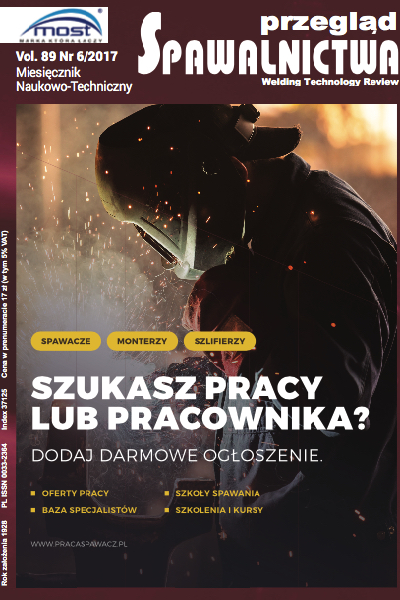Effect of Heat Input on Selected Quality Aspects of Pulsed Current GTAW Joints
Main Article Content
Abstract
There are many papers and investigations concerning the major in uence of heat input on microstructure and mechanical properties of welded joints. However, welded joints made with the same heat input dont exhibit the same quality and properties in every case. The article presents the review of literature dealing with heat input issues and possibilities of optimization of pulsed current GTAW process parameters.
in polish
Wpływ energii liniowej na wybrane aspekty jakości połączeń spawanych elektrodą nietopliwą z zastosowaniem prądu pulsującego
Istnieje wiele opracowań naukowych, które podkreślają wpływ energii liniowej spawania na mikrostrukturę i własności złącza. Niemniej jednak znane są przypadki, gdy elementy spawane przy tej samej lub zbliżonych wartościach energii liniowej różnią się znacznie jakością. Artykuł zawiera przegląd literatury poświęconej zagadnieniom związanym z energią liniową oraz z możliwościami optymalizacji parametrów procesu przy spawaniu metodą GTAW prądem pulsującym.
Downloads
Article Details
Creative Commons CC BY 4.0 https://creativecommons.org/licenses/by/4.0/
Welding Technology Review (WTR) articles are published open access under a CC BY licence (Creative Commons Attribution 4.0 International licence). The CC BY licence is the most open licence available and considered the industry 'gold standard' for open access; it is also preferred by many funders. This licence allows readers to copy and redistribute the material in any medium or format, and to alter, transform, or build upon the material, including for commercial use, providing the original author is credited.
References
R. Kensik: Ocena energii liniowej w procesach MIG/MAG, Przegląd Spawalnictwa 9-10/2006.
K. Kudła, K. Wojsyk: Normowana energia liniowa a ilość ciepła wprowadzanego podczas spawania, Przegląd Spawalnictwa 12/2010.
R. Scot Funderburk: A look at Heat Input, Welding Innovation Vol. XVI, N0. 1. 1999.
Zmiany w normach ASTM dotyczących obliczania energii liniowej, Biuletyn Informacji Technicznej LEB2/2010 Lincoln Electric.
PN-EN 1011-1 Spawanie Zalecenia dotyczące spawania metali Część 1: Ogólne wytyczne dotyczące spawania łukowego.
E. Tasak: Metalurgia spawania, 2008, ISBN 978-83-923191-1-5.
Y. Hirata: Pulsed arc welding, Welding International, 2003, 17 (2), pp. 98-115.
M. Kureishi: A Study on Welding Conditions for the Pulsed TIG Welding by the Theory of Heat Conduction, Journal of the Japan Welding Society, Vol. 48, 1979, No. 12 P, pp. 1033-1040.
C. S. Wu, W Zheng and L. Wu: Modelling the transient behavior of pulsed current tungsten inert gas weldpools, Modelling Simul. Mater. Sci. Eng. 7, 1999, pp. 15-23.
A. Traidia: Multiphysics modeling and numerical simulation of GTA weld pools (Ph. Thesis - 2011), HAL Archives Ouvertes.fr.
L. Verwaerde, R. Katiyar: Wpływ sterowania charakterystyką prądu
na kształt spoiny i właściwości mechaniczne stopiwa, Przegląd Spawalnictwa 7-8/2009.
P. Sejc, R. Kubicek: In uence of Heat Input on the Content of Delta Ferrite in the Structure of 304L Stainless Steel GTA Welded Joints, Scientic Proceedings 2011, Vol. 19, 2011, pp. 8-14.
P. K. Giridharan, N. Murugan: Optimization of pulsed GTA welding process parameters for the welding of AISI 304L stainless steel sheets, Int. J. Adv. Manuf. Technol, 2009, 40: 478-489.
M. Arivarasu, K. Devendranath Ramkumar, N. Arivazhagan: Comparative Studies of High and Low Frequency Pulsing On the Aspect Ratio of Weld Bead in Gas Tungsten Arc Welded AISI 304L Plates, Procedia Engineering 97, 2014, pp. 871-880.
K. H. Tseng, C. P. Chou: The Effect of Pulsed GTA Welding on the Residual Stress of a Stainless Steel Weldment, Journal of Materials Processing Technology 123, 2002, pp. 346-353.
M. Youse eh, M. Shamanian, and A Saatchi: Optimization of Experimental Conditions of the Pulsed Current GTAW Parameters for Mechanical Properties of SDSS UNS S32760 Welds Based on the Taguchi Design Me- thod, JMEPEG (2012) 21: 1978-1988.
Ravindra Kumar, Ramkishor Anant, P. K. Ghosh, Ankit Kumar, and B. P. Agrawal: In uence of PC-GTAW Parameters on Microstructural and Mechanical Properties of Thin AISI 1008 Steel Joints, JMEPEG, 2016, 25: 3756-3765.
N. Karunakaran: Effect of PulsedCurrent on Temperature Distribution, Weld Bead Pro les and Characteristics of GTA Welded Stainless Steel Joints, IJET Vol. 2, No. 12, Dec. 2012.
J. Joseph and S. Muthukumaran: Optimization of pulsed current GTAW process parameters for sintered hot forged AISI 4135 P/M steel welds by simulated annealing and genetic algorithm, J. Mech. Sci. and Tech., 30 (1), 2016, pp. 145-155.
M. Youse eh, M. Shamanian, A. R. Arghavan: Analysis of Design of Experiments Methodology for Optimisation of Pulsed Current GTAW Process Parameters for Ultimate Tensile Strenght of UNS S32760 Welds, Metallogr. Microstruct. Anal., 2012, 1: 85-91.
J. Kangazian, M. Shamanian: Multiresponse Optimization of Pulsed-Current Gas Tungsten Arc Welding (PCGTAW) for AISI 304 Stainless Steel to St 52 Steel Dissimal Welds, Metallogr. Microstruct. Anal., 2016, 5: 241-250.
A. A. Ugla: A Comparative Study of Pulsed and Non-Pulsed Current on Aspect Ratio of Weld Bead and Microstructure Characteristics of AISI 304L Stainless Steel, Innovative Systems Design and Engineering, Vol. 7 No.4, 2016.
A. A. Ugla: Characterisation of Metallurgical and Mechanical Properties of the Welded AISI 304L Using Pulsed and Non-Pulsed Current TIG Welding, International Journal of Chemical, Molecular, Nuclear, Materials and Metallurgical Engineering ,Vol: 10, No: 4, 2016.
P. Cegielski, A. Kolasa, M. Kuczyński, R. Rostkowska: Wybrane aspekty pomiarów i monitorowania podczas spawania łukowego, Przegląd Spawalnictwa 12/2016.
M. Youse eh, M. Shamanian, and A Saatchi: Optimization of the pulsed current gas tungsten arc welding (PCGTAW) parameters for corrosion resistance of super duplex stainless steel (UNS S32760) welds using the Taguchi method, Journal of Alloys and Compounds 509, 2011, pp. 782-788.
